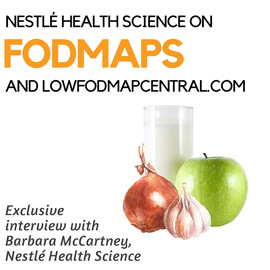Nestlé Health Science on FODMAPs and LowFODMAPCentral.com
- Like
- Digg
- Del
- Tumblr
- VKontakte
- Buffer
- Love This
- Odnoklassniki
- Meneame
- Blogger
- Amazon
- Yahoo Mail
- Gmail
- AOL
- Newsvine
- HackerNews
- Evernote
- MySpace
- Mail.ru
- Viadeo
- Line
- Comments
- Yummly
- SMS
- Viber
- Telegram
- Subscribe
- Skype
- Facebook Messenger
- Kakao
- LiveJournal
- Yammer
- Edgar
- Fintel
- Mix
- Instapaper
- Copy Link
Posted: 27 April 2016 | Victoria White, Digital Content Producer | No comments yet
Barbara McCartney, Regional Business Head for the Nestlé Health Science Consumer Care Business in North America, talks to New Food about FODMAPs and Nestlé Health Science’s new web resource, LowFODMAPCentral.com…


Nestlé Health Science recently launched LowFODMAPCentral.com, a unique comprehensive online resource offering information and printable guides about FODMAPs and a Low FODMAP Diet.


TheLowFODMAPCentral.com website has been developed to support both the consumer seeking more information about a Low FODMAP Diet and the healthcare professional looking to build knowledge and practice tools.
Gastroenterology researchers at Monash University in Australia coined the FODMAP acronym in 2005 to classify specific types of short-chain carbohydrates that can be poorly absorbed in the small intestine. New Food contacted Barbara McCartney, Regional Business Head for the Nestlé Health Science Consumer Care Business in North America, to find out more about FODMAP and the new web resource.
Barbara explained FODMAPs in more detail: “FODMAP stands for Fermentable Oligosaccharides, Disaccharides, Monosaccharides And Polyols. They are a group of short-chain carbohydrates that can be poorly absorbed in the small intestine. It is the poor absorption of these food components that may trigger symptoms including abdominal pain, bloating, constipation and/or diarrhoea and excessive gas in people with digestive sensitivities. FODMAPs are commonly found in a wide variety of ordinary foods, such as wheat bread, beans, yogurt, milk, apples, onions, garlic, cashews, mushrooms, honey, and more.”
Increasing awareness of FODMAPS
LowFODMAPCentral.com is developed by Nestlé Health Science to increase awareness of FODMAPs, as Barbara explained: “Nestlé Health Science understands the importance of nutrition in health and is focused on developing solutions to advance the role of nutrition in health management. They decided to launch LowFODMAPcentral.com to increase the awareness of FODMAPs and the role they can play in people with digestive sensitivities.”
The comprehensive site includes a variety of information on FODMAPs and foods that contain them. It has animated visuals of FODMAPs in the body; tools that can help a person identify if this diet is right for them; research summaries highlighting the efficacy of a Low FODMAP Diet; recipes and guidance for following a Low FODMAP Diet both at home and away; and tips for finding a FODMAP knowledgeable registered dietitian nutritionist.
The website is aimed at both consumers and healthcare professionals, as Barbara explained: “LowFODMAPcentral.com was created both for the consumer as well as the healthcare professional. Nestlé Health Science wants to reach consumers who are suffering from digestive discomfort and are looking for information. For the healthcare professional, such as a registered dietitian nutritionist, the website offers educational resources to help them in their support of patients and clients with digestive sensitivities.”
Low FODMAP diet as first-line therapy for IBS
The International Foundation for Functional Gastrointestinal Disorders estimates that 10 to 15 percent of Americans are affected by food-related digestive discomfort including Irritable Bowel Syndrome (IBS). For many, the exact cause of their digestive discomfort may go undiagnosed.
Clinical evidence supports a low FODMAP diet approach as first-line therapy for people with IBS. Although the list of potential food triggers may at first seem extensive, a credentialed nutrition FODMAP expert can customise a plan that minimises food eliminations and maximises nutritional value, and provides tools and resources that can help support dietary compliance. LowFODMAPcentral.com will provide healthcare professionals with resources that can help them support their patients.
Nestlé Health Science plans to evaluate the effectiveness of LowFODMAPcentral.com over time, as Barbara explained: “This website is meant to be a supportive tool for the community. Nestlé Health Science plans to measure the effectiveness of the site through surveys and feedback obtained through building relationships with the healthcare community.”
You can find out more about FODMAPs and a low FODMAP diet at: https://www.nestlehealthscience.us/lowfodmap








